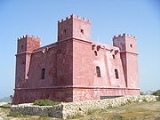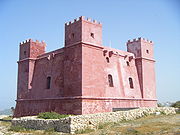
St. Agatha's Tower
Encyclopedia
St. Agatha's Tower in Malta
is similar in style to the Wignacourt towers
, though it was completed in 1649 during the Grand Mastership of Juan de Lascaris-Castellar to a design by Antonio Garsin. It is also known as the Red Tower due to the colour it is painted.
 The original structure is a square tower with four square corner towers with cannon ports in the towers giving interlocking fields of fire commanding the base of the walls and the gateway, with large cannon ports in the faces of the main tower. The outer walls are approximately four meters thick at the base and the interior of the tower is enclosed by a barrel vaulted roof. The corner towers are surmounted by very characteristic fish tail crenelations.
The original structure is a square tower with four square corner towers with cannon ports in the towers giving interlocking fields of fire commanding the base of the walls and the gateway, with large cannon ports in the faces of the main tower. The outer walls are approximately four meters thick at the base and the interior of the tower is enclosed by a barrel vaulted roof. The corner towers are surmounted by very characteristic fish tail crenelations.
The Tower is situated in a commanding position on the crest of Marfa Ridge at the north west end of Malta, overlooking the natural harbour and obvious landing site of Mellieħa Bay with clear views over to Comino
and Gozo
, and also eastward to the line of watchtowers along the north shore of Malta that linked it with the Knights headquarters in Valletta
. It was the Knights' primary stronghold in the west of Malta, and was manned by a garrison of 30 men, with ammunition and supplies to withstand a siege of 40 days.
Like many of the Knights' early defensive structures, during the 18th century it was strengthened by the addition of a much lower profile battery around its flanks. It continued to have a military function throughout the British period, and was manned during both World Wars. From the British
period it continued its military function being used as a radar station by the Armed Forces of Malta
.
By the close of the 20th century the tower was in poor repair with one turret completely missing and another turret severely damaged. The Tower was the substantially restored by Din l-Art Helwa
starting in 1999, with restoration being completed in 2001, assisted by substantial industrial sponsorship. As part of the restoration work the damaged towers were replaced, the walls and were roof rebuilt and eroded stone facing replaced, the interior walls scraped and painted, the original floor uncovered, and the interior staircase to the roof rebuilt. Due to the extreme unevenness of the floor, this was recently covered by a wooden surface with glass apertures through which one can view the original slabs. The Tower is now in the care of Din l-Art Helwa and is open to the public.
Malta
Malta , officially known as the Republic of Malta , is a Southern European country consisting of an archipelago situated in the centre of the Mediterranean, south of Sicily, east of Tunisia and north of Libya, with Gibraltar to the west and Alexandria to the east.Malta covers just over in...
is similar in style to the Wignacourt towers
Wignacourt towers
The Wignacourt towers are a series of fortifications on the island of Malta built by the Knights of Malta.The initial towers of this type were built under the auspices of Grand Master Fra Aloph de Wignacourt...
, though it was completed in 1649 during the Grand Mastership of Juan de Lascaris-Castellar to a design by Antonio Garsin. It is also known as the Red Tower due to the colour it is painted.

The Tower is situated in a commanding position on the crest of Marfa Ridge at the north west end of Malta, overlooking the natural harbour and obvious landing site of Mellieħa Bay with clear views over to Comino
Comino
Comino is an island of the Maltese archipelago between the islands of Malta and Gozo in the Mediterranean Sea, measuring in area. Named after the cumin seed that once flourished in the Maltese islands, Comino is noted for its tranquility and isolation. It has a permanent population of only four...
and Gozo
Gozo
Gozo is a small island of the Maltese archipelago in the Mediterranean Sea. The island is part of the Southern European country of Malta; after the island of Malta itself, it is the second-largest island in the archipelago...
, and also eastward to the line of watchtowers along the north shore of Malta that linked it with the Knights headquarters in Valletta
Valletta
Valletta is the capital of Malta, colloquially known as Il-Belt in Maltese. It is located in the central-eastern portion of the island of Malta, and the historical city has a population of 6,098. The name "Valletta" is traditionally reserved for the historic walled citadel that serves as Malta's...
. It was the Knights' primary stronghold in the west of Malta, and was manned by a garrison of 30 men, with ammunition and supplies to withstand a siege of 40 days.
Like many of the Knights' early defensive structures, during the 18th century it was strengthened by the addition of a much lower profile battery around its flanks. It continued to have a military function throughout the British period, and was manned during both World Wars. From the British
British Empire
The British Empire comprised the dominions, colonies, protectorates, mandates and other territories ruled or administered by the United Kingdom. It originated with the overseas colonies and trading posts established by England in the late 16th and early 17th centuries. At its height, it was the...
period it continued its military function being used as a radar station by the Armed Forces of Malta
Armed Forces of Malta
The Armed Forces of Malta is the name given to the combined armed services of Malta. The AFM is a brigade sized organisation consisting of a headquarters and three separate battalions, with minimal air and naval forces.- Headquarters, AFM :...
.
By the close of the 20th century the tower was in poor repair with one turret completely missing and another turret severely damaged. The Tower was the substantially restored by Din l-Art Helwa
Din l-Art Helwa
Din l-Art Helwa, National Trust of Malta, is a non-governmental, non-profit, voluntary organisation founded in 1965 to safeguard Malta's cultural heritage and natural environment. Since its foundation, Din l-Art Helwa has restored numerous cultural sites of immense historic and environmental...
starting in 1999, with restoration being completed in 2001, assisted by substantial industrial sponsorship. As part of the restoration work the damaged towers were replaced, the walls and were roof rebuilt and eroded stone facing replaced, the interior walls scraped and painted, the original floor uncovered, and the interior staircase to the roof rebuilt. Due to the extreme unevenness of the floor, this was recently covered by a wooden surface with glass apertures through which one can view the original slabs. The Tower is now in the care of Din l-Art Helwa and is open to the public.
External links
- http://www.dinlarthelwa.org/content/view/46/55/
- http://www.educ.um.edu.mt/militarymalta/html/red_tower.html

